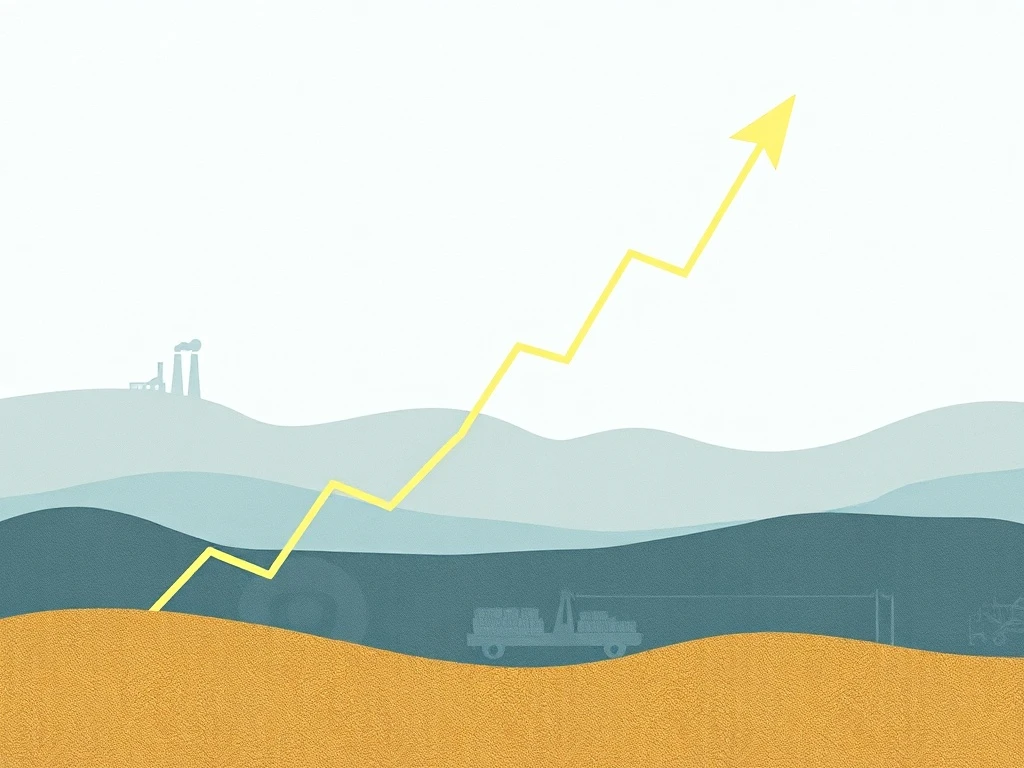Entrepreneurs and business leaders closely monitor economic indicators. Therefore, the latest data showing a significant **Wholesale Prices Surge** demands immediate attention. This surge, the largest in three years according to the Producer Price Index (PPI), signals a concerning trend. It points to growing inflationary pressures, largely tied to recent tariffs. Understanding these dynamics is crucial for strategic planning and mitigating potential impacts on your operations.
Understanding the **Wholesale Prices Surge**: What the PPI Reveals
The Producer Price Index (PPI) measures the average change over time in the selling prices received by domestic producers for their output. It serves as a key indicator of inflation at the wholesale level. Essentially, it tracks the costs businesses face for goods and services before they reach consumers. A significant rise in the PPI often precedes an increase in consumer prices.
Recently, the PPI posted its most substantial increase in three years. This jump indicates that producers are paying more for their inputs. Consequently, these higher costs typically get passed down the supply chain. Businesses, therefore, face increased operational expenses. This can affect profitability and consumer pricing strategies.
The Mechanics Behind the PPI Increase
Several factors contribute to movements in the PPI. However, the current **Wholesale Prices Surge** highlights specific economic forces. Analysts point to a confluence of demand-side pressures and supply-side constraints. Furthermore, global trade dynamics play a significant role. These elements combine to push producer costs higher.
Key components of the PPI include:
- Goods: Prices for raw materials, intermediate goods, and finished goods.
- Services: Costs for transportation, warehousing, and other business services.
- Construction: Prices for inputs related to building and infrastructure projects.
Each component can influence the overall index. Therefore, a broad-based increase across these categories suggests widespread inflationary pressure.
Tariffs: A Direct Driver of the **Wholesale Prices Surge**
One of the most prominent explanations for the current **Wholesale Prices Surge** is the impact of tariffs. Tariffs are taxes imposed on imported goods. When a country imposes tariffs, the cost of those imported goods increases for domestic businesses. These businesses then either absorb the cost or pass it on.
For instance, tariffs on steel or aluminum directly increase manufacturing costs. Similarly, duties on imported components affect electronics producers. Consequently, these higher input costs ripple through the economy. They directly contribute to the PPI’s upward movement. Businesses relying heavily on imported materials feel this impact acutely.
How Tariffs Inflate Costs
Tariffs operate in a straightforward manner to increase prices:
- Increased Import Costs: Importers pay more for goods subject to tariffs.
- Supply Chain Adjustments: Businesses may seek alternative, potentially more expensive, domestic suppliers.
- Reduced Competition: Tariffs can reduce the supply of certain goods, leading to higher prices due to less competition.
- Retaliatory Tariffs: Other countries may impose their own tariffs, impacting export-oriented businesses.
Therefore, the tariff landscape directly influences the cost structure for many industries. This translates into higher **Wholesale Prices Surge** figures.
Impact on Businesses: Navigating Rising Input Costs
The **Wholesale Prices Surge** presents significant challenges for businesses across various sectors. Rising input costs squeeze profit margins. Companies must decide whether to absorb these costs or pass them on to consumers. Each choice carries distinct implications for market share and profitability.
Small and medium-sized enterprises (SMEs) often feel the pinch more acutely. They may lack the purchasing power of larger corporations. Furthermore, they might have less flexibility in their supply chains. Consequently, they must adapt quickly to these changing economic conditions.
Strategies for Businesses Amidst Rising Wholesale Prices
Businesses can adopt several strategies to mitigate the impact of the **Wholesale Prices Surge**:
- Supply Chain Diversification: Explore new suppliers, both domestic and international, to reduce reliance on tariff-affected regions.
- Cost Optimization: Identify areas for internal cost savings, such as energy efficiency or process improvements.
- Pricing Adjustments: Carefully consider incremental price increases to offset higher input costs, while monitoring competitive landscapes.
- Inventory Management: Optimize inventory levels to avoid holding expensive stock for too long, but also to ensure availability.
- Hedging: For businesses heavily reliant on specific commodities, consider financial instruments to hedge against price volatility.
Proactive planning is essential. Businesses that anticipate these shifts are better positioned to maintain stability and competitiveness.
Consumer Implications: The Ripple Effect of the **Wholesale Prices Surge**
Ultimately, the **Wholesale Prices Surge** impacts consumers. Businesses facing higher costs often pass a portion of these increases onto their customers. This manifests as higher retail prices for goods and services. Consequently, consumer purchasing power can diminish.
When consumers pay more for everyday items, their disposable income decreases. This can lead to reduced spending on non-essential goods and services. Therefore, the ripple effect of wholesale inflation can slow overall economic growth. It also directly affects household budgets.
Everyday Impact on Households
Consider these everyday examples of how the **Wholesale Prices Surge** can affect households:
- Groceries: Higher costs for agricultural products and food processing can lead to more expensive food at the supermarket.
- Electronics: Tariffs on components can increase the price of smartphones, laptops, and other gadgets.
- Apparel: Increased costs for textiles and manufacturing can drive up clothing prices.
- Automobiles: Higher steel and aluminum prices can translate into more expensive cars.
These examples illustrate the broad reach of wholesale inflation. It affects nearly every aspect of consumer spending.
Broader Economic Outlook: Inflationary Pressures and Policy Responses
The significant **Wholesale Prices Surge** also influences the broader economic outlook. Persistent inflation can prompt central banks to adjust monetary policy. Specifically, they might consider raising interest rates. Higher interest rates aim to cool down an overheating economy by making borrowing more expensive.
However, raising interest rates also carries risks. It can slow economic growth and investment. Policymakers face a delicate balancing act. They must control inflation without stifling economic expansion. The PPI data provides critical information for these policy decisions.
Potential Economic Scenarios
The current inflationary trend could lead to several economic scenarios:
- Stagflation Risk: A combination of high inflation and stagnant economic growth.
- Controlled Soft Landing: Inflation cools without a significant economic downturn.
- Persistent Inflation: Inflation remains elevated, requiring more aggressive policy actions.
Monitoring future PPI reports will be essential. These reports offer early signals of economic shifts. Furthermore, they inform government and central bank strategies.
Looking Ahead: Navigating Future **Wholesale Prices Surge**
The recent **Wholesale Prices Surge** is a clear signal of ongoing economic challenges. Businesses and consumers alike must prepare for potential continued price increases. While tariffs are a significant factor, other global and domestic forces also contribute to inflation. These include supply chain disruptions and strong consumer demand.
Staying informed about economic data is paramount. Businesses should regularly review their pricing models and supply chain resilience. Consumers, meanwhile, may need to adjust their budgeting and spending habits. Economic indicators like the PPI provide valuable foresight in a dynamic global economy.
In conclusion, the substantial **Wholesale Prices Surge** highlights the complex interplay of trade policy and inflation. It underscores the need for adaptability and strategic foresight in the current economic climate. Both businesses and individuals must remain vigilant to navigate these evolving pressures effectively.
Frequently Asked Questions (FAQs)
Q1: What is the Producer Price Index (PPI) and why is it important?
The Producer Price Index (PPI) measures the average change in selling prices received by domestic producers for their output. It is important because it serves as an early indicator of inflationary pressures. A rise in the PPI often signals that higher costs for businesses may soon translate into higher consumer prices.
Q2: How do tariffs contribute to a **Wholesale Prices Surge**?
Tariffs are taxes on imported goods. When tariffs are imposed, the cost of these imported goods increases for domestic businesses. Businesses then either absorb these higher costs, which impacts their profit margins, or pass them on to their customers, leading to a rise in wholesale prices.
Q3: What does a **Wholesale Prices Surge** mean for consumers?
A **Wholesale Prices Surge** typically means that consumers will eventually face higher retail prices for goods and services. Businesses, confronted with increased input costs, often pass these expenses onto the end consumer. This can reduce consumer purchasing power and impact household budgets.
Q4: What actions can businesses take to mitigate the impact of rising wholesale prices?
Businesses can implement several strategies. These include diversifying their supply chains, optimizing internal costs, making careful pricing adjustments, and improving inventory management. Some larger businesses may also consider hedging against commodity price volatility.
Q5: Is the current **Wholesale Prices Surge** solely due to tariffs?
While tariffs are a significant contributing factor, the current **Wholesale Prices Surge** is often influenced by a combination of factors. These can include strong consumer demand, ongoing global supply chain disruptions, and geopolitical events. Tariffs, however, play a direct and measurable role in increasing import costs.
Q6: How does the **Wholesale Prices Surge** affect the broader economy?
A significant **Wholesale Prices Surge** can signal broader inflationary trends, potentially prompting central banks to raise interest rates to control inflation. This can slow economic growth and investment. Persistent inflation can also lead to reduced consumer spending and overall economic instability if not managed effectively.








